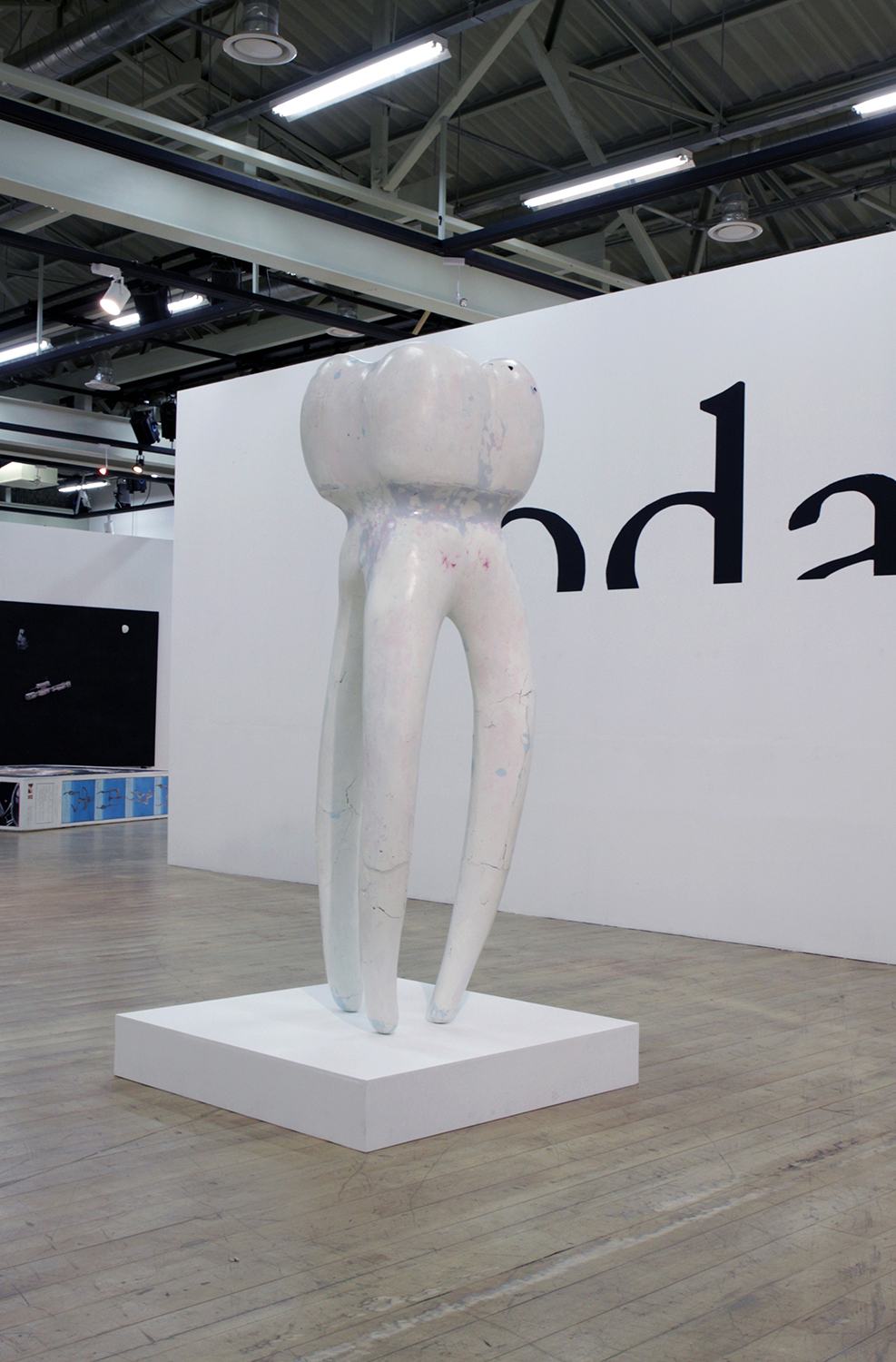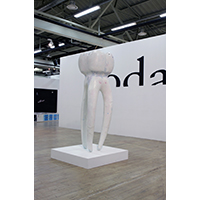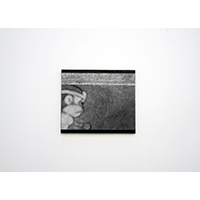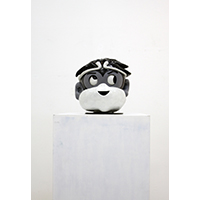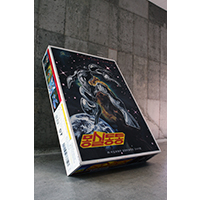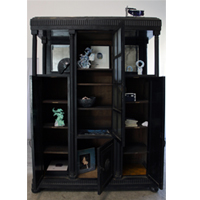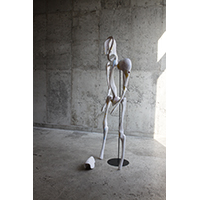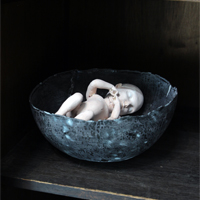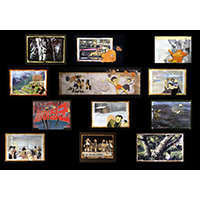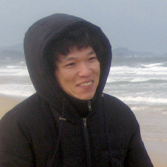
Sangwoo Kang, Savina Museum of Contemporary Art

Birth
1977, Seoul
Genre
Painting, Sculpture, Installation
Homepage
The time traveler, The image alchemist Sangwoo Kang's Small pictures and installation
Sangwoo Kang's time passes in counterclockwise motion. Kang’s works are like looking at his past through the hole. It is more correct to say that as if he sticks his head out into the hole rather than just circling around the hole. He does not remain here, in fact he remains there. There is no present for him. For him, the state of the present comes as neither meaningless greyish space nor soundless conversations taking place in unrealistic realm. The only light captured by his conscious dose not exists here, it lies with his past and dreams. While he is obsessed with images, events, people and certain facts that are inhibits his memories, he gets the greatest fuzz out of recording his own observations and analysis of his own feelings and attitudes. Kang investigates his change of moods through the medium of personal memoires and memoir that reinforceable and variable and even extinctable for personal benefit. Then he re-constructs and re-produces those memories into drawings, paintings, sculptures, installations and photographs. Sometimes he emprunts movies, videos, animations advertisements or masterpieces that are imprinted in his mind.
Around 1500 colour drawings smaller than the size fists and just bigger than the size of fried egg are drawn in A5 size sketchbook made over the ten years is the trail of his own time travel stories. He uses conté, transparent marker pen according to his secretive technique. Do not be fool by the size, it contains such a fine details and aura easily match for the fine paintings. There are great ranges of repertory. First of all, childhood memories or imagination, dreams related to his family captures at the first sight. ‘A mummy whale and a baby whale’, old dolls and toys, the snack time with two brothers, gently messaging mum’s arms are the common subject matter between a mother and a child. There is a picture where Kang captured the essence of the first encounter of his niece. Sangwoo Kang said such a scenery of quiet and peaceful suburbia while he was studying aboard might have triggered nostalgic feelings towards his own childhood memories. He continues to capture the U.F.O, clouds at night sky, drawing of Icarus and the imagery and the scenery of his vivid dreams. Kang continues to capture what is appears to be instant moments played by the act of ludicrously and eccentrically, such as a girl annoyed because she was unable to spit out chewing-gum from her mouth happened somewhere in Dutch street, flipped car on upside down road and etc. In addition, he makes or arranges his nostalgic feelings towards images awaken by the motion pictures, music, cartoonistic illustrations, sometimes western paintings and prints are appropriated. There is a picture which contains a poster image of the motion picture tilted ‘Doll Eye’, incapturating the moment of when Guan Yu‘s head armor got stricken by a Huang Zhong’s arrow in Woo Young Go’s cartoon ‘Three Kingdoms’, San Wol Lim’s member Chang Whan Lee’s song, American country musician Jonny Cash, the motion picture ‘Whale Hunting’, Hyun Se Lee’s ‘Fearsome Wae In Gu Dan’. Certain images are given direct, specific and expressive approaches, other images are given metaphorical, abstract, and encoded approaches.
'Sleeping Beauty'(2008) is a small sculptural piece which evoked feeling of fear when he encountered certain image during his childhood, as it provides insight of how the artist choose to use his images regards to his memories and feelings.
It was 1985 while Sangwoo Kang was attending primary school 23 years ago he had his first encounter with Walt Disney’s animation, later he realized the source of his fear came from particular scene opposing to be more dimensional than other scenes within the animation. He has intended to conceptualize the shocking feelings by recreating the ‘truth’ about his experience. To actualize this, he places a female figure facing the wall so that her abundant hair and dress wrapped around her back line can be revealed as it’s shown in the animation. And the rear side(invisible side un-shown in the animation) reminds the beauty stunned by the witch’s prickly forest with the claw marks deep as cliff. It metaphorically deigns to evoke fear, which is associated with a witch’s magic. Realistic and strange way, it could be called ‘Deconstructional Realism’ the way he led the image. Like useless, pointless and small(highlight the fact small-for-size) object similar to melted candle wax. It is informalized(formless form), semi-structionalized(anti form). The object has qualities originated from his childhood, impacted both physically and constructionally expanded its territories like installations made by the theater designer, in same time it takes the affects of psychological deconstruction.
'Ill Zeeman' 2009 is a work taken from clothes manufacturer company’s logo which turned into dimensionalized form. It started from the artist's curiosity of an image of a boy' body in the logo. As the image turned its shape into three dimensional form from two dimensional form, clues and sign can be added onto the image. For example, to create a sculptural piece of a boy (like a mentally disabled person or physically disabled person) driveling, Kang finds then adds imaginative mental state or illnesses. Overall, Kang’s subject matter of his installation works has personal quality, has a strong focus and has sensitive craft quality. Perhaps his approach (internal approach) might have originated from intense concentration. 'Trace'(2007), 'Is Anyone Here, Except Jerry?''(2007), 'Landscape'(2007), 'Sweet'(2007), 'Rain Brings Misery'(2009), 'Horizon&Skull'(2009) share similar feelings. Kang is currently working on ‘Project Rapture’. Since he has witnessed ‘rapture incidence’ in same time he began to take personal interest in the context of Christianity in 1992, he was deeply feared by the unavoidable images relate to existence of god and heaven and hell. This is one of the works displayed on the floor presented in this show.
For Sangwoo Kang, livings in fantasia land thicken by cloudy night sky and devotion for the unique art (“Making art is only thing I can do”) has same weight. There is no relation between himself and the current state of mind, perhaps, apart from the weather and the music, his sole energy is consumed by searching for the ways of pulling out his memories from the past, the things he can appropriate, taking references. He said he might make works about Korean television series ‘Soon Poong Obstetrics and Gynecology’ which became a hit ten years ago.
He has no interest in what people do. According to him, for that reason he has chosen to study abroad in Netherlands. He has faith in art as much as religion. It is pure, there is something about his seriousness and there is also something about his weightlessness, personally I feel anxious about these choices. There is a sculptural piece called 'The Cloud of the Rapture'(2008). It is actual model of clouds with full of apocalyptic moods motivated by collection of illustrations made by the apocalypticist. The word ‘Rapture’ has duel meaning (it means the greatest joy however it also means the clouds of the day of apocalypse). His overall image overlaps with this image of clouds. “I am really curious about my future” taken from his sketchbook. I can only hope that apocalypse will miss his art.
Wan Kyoung Sung(Art Critic)
Shout at the Wall
The artist’s reality is no different from any other reality.
It is the content that gives the perceptions and observations of an artist(within the presentation art).
A use factor within the society.
- Lawrence Weiner, Notes Around & About Art, Art Journal, 1982 Summer
‘Shout at the Wall: Sangwoo Kang Solo Exhibition’ revisits the reality of 1982. Korean Pro Baseball, beloved by Kang's brothers and friends, was launched in March '82. That same year in September, Korean baseball wins the 28th World Baseball Competition. In Kang's personal history, this year immediately follows his father's release from months-long imprisonment, accused of publishing seditious books; Chun Doo-hwan, President at the time, lifted the night curfew; meanwhile, Kim Dae-jung had to exile himself in the U.S. Abroad, Grace Kelly died in a traffic accident; Hak Kyung Cha was shot and murdered by un unnamed assailant in New York; and Gabriel Garcia Marquez was awarded the Nobel Prize in Literature for ‘One Hundred Years of Solitude(Cien anos de soledad)’, which addresses the socio-political realities of Central and South America.
The Reagan administration, upon realizing that the Korean government had been confidentially promoting nuclear development using plutonium since '82, demanded the suspension of the plan. In 1983, former President Chun promised to forego nuclear development to the U.S. government in order to secure support have the administration's legitimacy affirmed. Efforts to control and pacify the public were made, such as hurried implementation of Pro baseball/football and color TV broadcasting, and policies such as alleviation of censorship regarding sexual representations in film and TV drama, and liberalization of school dress code. On May 25th 1983, a commentary on Kyunghyang Daily News coins the term "3S" (Screen, Sports, and Sex) in reference to the dominant mood of the time. Point out that there have been various strategies to mesmerize the public, which takes on the form of the 3S policy under Chun's governance, the author expressed his concern about how the system is distracting the people by implementing a festive atmosphere.
Kang remembers that his family harbored discontent towards the political situation, but had to mask and self-censor such sentiments. Even after 30 years, going through the Presidential election in 2012, this self-imposed silent treatment towards political issues remained unchanged. Shocked by the election result, Kang now wishes to bring the political problems of our present-day society into the public sphere. Kang reinterprets political issues through his works using general and familiar visual signs that relate to specific political figures, instead of exhibiting an educative attitude or resorting to conceptual and artistic representation. Examples include his use of honeysuckle plants, desks that remind the viewers of visiting rooms in prison, or paintings that have texts such as "Republic" inscribed on them.
The exhibition title, ‘Shout at the Wall’, implies that the only thing former President Kim Dae-jung or his father could do in resistance to the broken history of Korea's modern society while in jail was shouting at the wall. The honeysuckle-shaped structure in Shout at the Wall and the self-replication seen in the words ("Love, Peace, Love They Neighbor") taken from the letters Kim wrote from jail in Study of Salvation, or paintings on Pro baseball transforms the exhibition hall into a stage that represents the two realities; that of '82, and Kim Dae-jung.
Tolstoy's short story collection "Oh Pilgrim of Love, Angst and Solitude," published by Kang's father in '85, became the catalyzer of the artist's political interest. The despair one of the character experiences runs parallel to the ordeals of Kim Dae-jung and the sense of loss or resentment towards god Kang's father had felt during imprisonment. Kang redesigns the print image in Tolstoy's book as a semi-transparent object, and reveals the texts hidden behind the structure. Kang notes that he was attempting to connect the attitude found in Russian literature about the suffering, destitute people and the techniques of woodcut prints, which is one of the representative forms of resistance art in Korea's modern and contemporary art history.
The realities of the '80s must differ in the minds of those who lived through the tumultuous time as an adult, and others who passed through the years in their childhood. Departing from childhood memories of his father and a specific politician who had a substantial influence on Korea's modern and contemporary political history, Kang revisits and reinterprets 1982 as a specific point in history. We now experience yet another reality the following generations lived through. Enthusiasm for professional baseball and the pains he had to suffer from his parents' political consciousness coexist in, and recurs in his life.
Jiyoon Yang(Curator)






